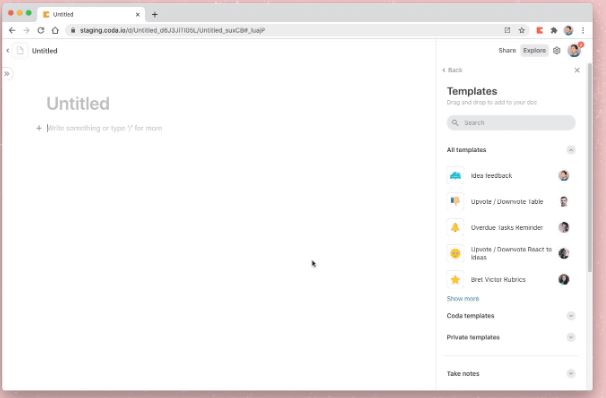
Coda.io is a powerful note-taking and document management solution. While it may not have the functionality of an all-in-one project management tool, it offers outstanding customization and flexibility for a variety of project management use cases. In this review of Coda.io, we highlight its pros, cons and standout features. We also detail pricing, some of the best alternatives to Coda.io and the top integrations for the tool.
Fast facts
| Gantt charts | Yes |
| Kanban boards | Yes |
| Mobile app | Yes |
| Desktop app | No |
| Document management | Yes |
| Workflow automation | Yes |
| Third-party integrations | 1000+ |
| Free plan | 7 days |
| Free plan | Yes |
| Starting price | $10 per user per month |
Jump to:
Pricing
Free
The free plan allows unlimited users; however, document size is limited to 50 objects. It comes with a limit of 1 GB on file attachments, up to 35 automations, manual data refresh and seven-day version history. If you’re looking for a free project management software tool for note-taking and document management, this plan might be enough for your requirements.
Pro
The Pro plan is priced at $10 per month per user with annual billing, or $12 per month per user with monthly billing. There is no limit on document size. The file attachment limit is 5 GB per document, while the automation limit is 100 time-based events or 500 event-based events. In the Pro plan, you can access real-time collaboration tools, publishing stats and a number of other advanced features.
Team
The Team plan is priced at $30 per month per user with annual billing, or $36 per month per user with monthly billing. In this plan, there is no limit on the number of users, document size, attachment size, or the number of automations. Along with all the features of the Pro plan, you unlock several advanced capabilities in the Team plan including private folders, custom domains, priority support, basic training with a Coda expert and more.
Enterprise
The pricing for the Enterprise plan is custom. You get all the features of the Team plan and more, including advanced user management, audit events, single sign-on, SOC 2 report, advanced locking and a dedicated customer success manager.
What is Coda.io used for?
Coda.io is a document editor system used for creating different types of files, such as spreadsheets, databases and documents. Users can make tables and add text, numbers, formulas, or other elements to the file. The software also offers collaboration and task-tracking features. Project management teams can create and manage documents for project planning and scheduling, as well as knowledge sharing. In addition, Coda.io is highly customizable, so users can create and manage workflows according to their needs.
Key features of Coda.io
Workflow automation
With Coda.io, users can create workflow rules to automate recurring tasks, without needing any coding (Figure A). Users can set a trigger as a starting point for automation, after which the software will automatically perform the user-defined action when the trigger is activated. Users can also add conditional logic to the automated actions.
Figure A

Formula Editor
The Formula Editor in Coda.io is designed to be read and written. If you are a heavy spreadsheet user, this feature is highly useful. Not only is it easy to enter or edit a formula, but it also makes debugging formulas easier.
Document management
Coda.io excels in document management capabilities. Users can create, edit and share documents, view version history, set access permission rules, attach files and access a variety of templates to suit their needs.
Templates
The Templates tool is another great feature in Coda.io. The software comes with in-built templates for a variety of applications, including spring planning, project briefs, road mapping and product design and launch. You can also create custom templates (Figure B).
Figure B

Pros
- Generous free plan.
- Highly customizable.
- Variety of templates.
- Powerful collaboration tools.
Cons
- No desktop app.
- Steep learning curve.
- Higher-priced plans get expensive for large teams.
Coda.io integrations
The functionality of Coda.io can be enhanced by integrating it with third-party applications. There are over 1000 integrations available, including the following:
- Pinterest: With this integration, you can directly import saved pins into any Coda document.
- Jira: You can plan software development in Coda while executing the plan in Jira. You can also use the project tracker to view planning and execution in one place.
- Slack: The Coda.io and Slack integration allows for seamless communication without needing to switch between applications. This means you can receive Coda.io notifications and updates directly within Slack channels.
- HubSpot: You can track deals in HubSpot CRM and use that data in Coda.io to track, forecast and plan.
Who is Coda.io best for?
Coda.io is versatile software with a variety of use cases. Its simplified approach to project management can benefit different types of users, although the pricing structure of Coda.io can make it expensive for larger teams. As such, Coda.io is slightly better suited for startups, freelancers and small teams, although larger organizations that can afford the higher pricing tiers will appreciate the integration capabilities, customizability and impressive set of features on offer.
SEE: Here are some of 2023’s top project management tools for startups.
If Coda.io isn’t ideal for you, check out these alternatives
While Coda.io offers an impressive set of features and is highly customizable, it might not be suitable for everyone. Here are the top three alternatives to Coda.io:
Asana
Asana is a complete project management solution with several project management features, including document creation and management. Coda.io offers more flexibility in creating and managing documents, and you also get more post-project tools for documents with Coda.io, such as project debrief write-ups, and the integration of project stats and analysis in project evaluations. The pricing for Asana starts at $10.99 per user per month.
For more information, see our full Asana review.
Notion
Notion has a lot of similarities with Coda.io, including its ‘building blocks’ user interface. You also get similar features, such as real-time collaboration and multiple views. A key advantage of Notion is that you get a desktop app, meaning you are not reliant on internet access to use the software. Pricing for Notion starts at $8 per user per month.
ClickUp
ClickUp is primarily a project management solution, while Coda.io is more customizable and offers a broader range of use cases. However, Coda.io does not offer advanced project management tools available in ClickUp, such as advanced resource management or issue tracking. ClickUp pricing starts at $5 per user per month.
For more information, see our full ClickUp review.
| Coda.io | Asana | Notion | Clickup | |
|---|---|---|---|---|
| Document management | Yes | Yes | Yes | Yes |
| Real-time collaboration | Yes | Yes | Yes | Yes |
| Advanced resource management | No | Yes | No | Yes |
| Gantt charts | Yes | Yes | No | Yes |
| Kanban boards | Yes | Yes | Yes | Yes |
| Desktop app | No | Yes | Yes | Yes |
| Spreadsheets | Yes | No | Yes | Yes |
| Mobile app | Yes | Yes | Yes | Yes |
Review methodology
For our review of Coda.io, we analyzed a wide range of parameters, including its basic and advanced features, pricing, use cases and capabilities. We also assessed how Coda.io performed in comparison to its competitors and reviewed customer feedback and ratings from reputable websites. For a deeper understanding of the usability of Coda.io, we performed a hands-on review of the software.
Read next: Notion review: Features, pricing & alternatives for 2023








